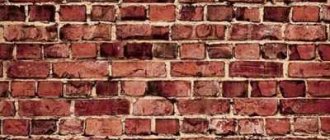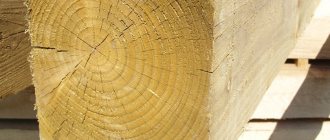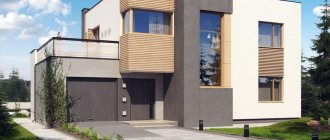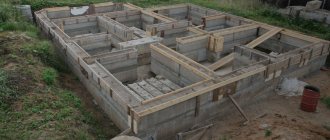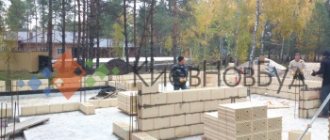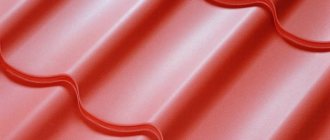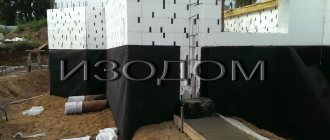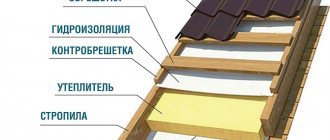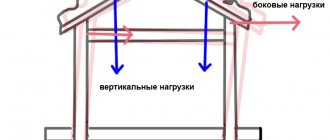Before starting construction of your future home, it is important to decide on the material that will be used. Many people prefer cellular concrete as a material for building walls. It has all the necessary characteristics to last for a long time. Cellular concrete implies a separate class of materials, with a similar structure, but different properties and characteristics. Let's look at the two most common of them, and find out which is better: foam block or gas block.
To compare these two materials, let's figure out what each is and consider their technical characteristics in relation to each other.
Foam block and gas block are building modules that are made by foaming a concrete mixture. Most often, such a cellular mass is used in the construction of internal and load-bearing walls and partitions. In some cases it is used for thermal insulation.
Strength
When choosing a foam block or aerated block, it is important to consider the strength of the material. This characteristic directly depends on porosity. The more porous the product, the lower the density and reliability, respectively. The most durable compositions are used in the construction of load-bearing structures, the least - in providing thermal insulation.
Foam block is a fairly durable material. And although its density is lower than that of brick or concrete, it also has good performance. Moreover, certain models of foam blocks can be used with additional reinforcement.
Due to its hygroscopicity, gas block is not the most durable material. It absorbs water very quickly, as it has open pores, and this is considered one of its main disadvantages. If aerated concrete is used in the construction of a house, then it is necessary to subsequently ensure effective waterproofing.
Foam concrete or aerated concrete - finishing features
For the external cladding of aerated concrete or foam concrete boxes, various finishing options are used: panels, plaster, tiles, lining. The thermal insulation characteristics of composites do not require additional thermal insulation of walls, provided the masonry thickness is sufficient. There are minor differences associated with the application of plaster:
- various types of plaster compositions adhere well to the aerated concrete surface;
- foam blocks are additionally reinforced with mesh for better contact with the plaster.
Mechanical treatment of the surface of foam concrete walls with emery or a grater also improves adhesion.
Fire hazard
Cellular concrete is a fire-resistant material that can withstand direct exposure to fire for a long time. The difference between foam block and aerated concrete in this aspect is that aerated concrete can withstand burning for up to seven hours, while for foam block these indicators are lower. Moreover, neither one nor the other material emits toxic fumes when exposed to flame, that is, it is not toxic.
What and how are materials made from?
Cellular concrete, which includes gas blocks and similar foam blocks, is made from lightweight cement. However, both varieties have differences in composition and production methods. There are two technologies for producing porous concrete: autoclave and non-autoclave. The first involves the hardening of raw materials at high pressure and temperature in sealed containers into which a large amount of water vapor is released. The non-autoclave method is suitable for use outside industrial production. Heating of the material occurs through the use of electricity at normal pressure.
Foam concrete is produced using a non-autoclave method in natural conditions. Synthetic or organic substances are added to the cement mass, which cause foaming of the mass. Next, the mixture is poured into special molds or formwork, in which it hardens.
Aerated blocks require the use of an autoclave method, so their production is possible only in a workshop. In addition to cement components and water, aerated concrete contains lime, gypsum, and chemical additives. The release of gases in the initial mass occurs due to the addition of aluminum in the form of powder or paste. The chemical reactions that occur in aerated concrete during the maturing stage cause the formation of hydrogen gas and the formation of cells. After the material has hardened, they begin to cut it into pieces.
A comparative analysis shows that the technological bases for the production of foam concrete and aerated concrete are significantly different. The composition of these cement materials is also not identical.
Moisture resistance
In terms of moisture resistance, foam concrete blocks or aerated concrete blocks have similar characteristics. Both of these materials are not moisture resistant.
Reduced water absorption is a property of foam blocks, which allows you to increase the service life of buildings. Due to the closed pores, foam concrete blocks, absorbing a small amount of water, are able to float better.
The moisture resistance of aerated concrete blocks is quite high. This is achieved even with a porous material structure. Due to the use of creation technology, aerated concrete remains dry, and moisture is released into the environment. Aerated blocks have greater moisture resistance than most other building materials.
Durability
A building made from aerated concrete blocks will be no less durable than one made from an alternative material. The main thing in operating such a house is to follow the maintenance recommendations.
It is important to carefully follow construction technology, and also purchase material only from trusted manufacturers. Then a house made of foam blocks will serve you better for several generations. After all, a correctly followed manufacturing process is a stable indicator of the quality of such a material, which has structural features.
Masonry material
Now let’s look at what nuances arise during the masonry process, and what are the instructions for laying foam concrete and gas silicate blocks with your own hands.
And it should be noted that the masonry technology does not differ from each other, both for one and for another material:
- The first row must be laid on a waterproofing layer, and the width of the waterproofing should be slightly wider than the blocks.
First row waterproofing
- The first layer is placed on a leveling solution to compensate for unevenness in the foundation.
- Laying the blocks begins from the highest angle, and the blocks are leveled using a building level and a rubber mallet.
Aligning Corner Blocks
- The second row is laid on a special adhesive for foam concrete. The glue is applied with a notched trowel to both the butt and horizontal seams.
- The blocks are laid on a newly applied layer of glue. Their location is controlled by a level and, if necessary, straightened with a rubber hammer.
- All rows are performed with bandaging to strengthen the masonry.
Scheme of correct block placement
- Load-bearing walls are tied with masonry or joined using anchors.
- As the height increases, be sure to check the vertical using a plumb line.
- The first row, as well as every fourth row, must be reinforced, thereby strengthening the masonry. Using a circular saw, a groove is cut on a horizontal surface into which the reinforcement is placed.
Masonry reinforcement
Price
Most companies producing building materials are engaged in the production of gas blocks. The price of the material directly depends on density, thermal conductivity and other technical characteristics. Looking at gas blocks of the same density and typical sizes, you can see that prices from the main domestic manufacturers are approximately the same. For example, a cubic meter of aerated concrete blocks will cost from 2500 – 2700 rubles/m3. This means that the average price for a block of 20×30×60 cm will be 92 rubles.
When purchasing foam concrete blocks, it is very important to know the volume of each of them, in order to subsequently calculate how many blocks of a given size are contained in 1 m3.
Foam blocks are produced in standard sizes: 200×300×600, 100×300×600. At the same time, many manufacturers accept orders for the manufacture of such products with any density. Depending on it, the weight of the material changes accordingly, and with it the price.
Aerated concrete
The material is obtained by mixing the filler and binder with water, alkaline additives, aluminum components, surfactants and plasticizers. Cements in an alkaline environment react with aluminum, releasing gas (hydrogen), and the building mixture foams, forming a homogeneous porous filling.
Note! This is the main difference between aerated concrete and foam concrete - in the method of pore formation: through the release of gas, or with the help of foam.
Appearance of gas blocks
Then, the set blocks are removed, sawn, processed and kept for some time. This produces a product called aerated concrete block. Depending on the purpose (thermal insulation or structural), they differ in technical characteristics, shape and size.
The required properties are achieved by different hardening technologies and mixture composition. The video in this article will help you understand the processes leading to pore formation in a gas block.
The higher the density grade, the finer the porosity will be.
Note: gas silicate is, by and large, the same as aerated concrete (pores in which are formed due to the addition of aluminum powder, which releases gas during a chemical reaction with alkalis), but the main binder in the composition is lime. Accordingly, gas silicate differs from foam concrete in the same parameters as aerated concrete.
The mixture may also contain additives to regulate structure formation, increase plastic strength, accelerate hardening and plasticizing components. Some of them can also be added to foam concrete. It turns out that on this point there are no differences between foam blocks and aerated concrete blocks.
Pros:
- The properties of sound and thermal conductivity are directly dependent on the porosity of the material, and, therefore, a wall built from blocks of a loose “spongy” structure will have good heat and sound insulation.
- Also, this material has greater strength among the group of lightweight concrete, and can be used for the construction of buildings up to 3 floors.
- The large dimensions of the products and the ease of working with them allow you to save time and effort when building a structure. The weight of a typical D500 block with dimensions 300x250x600 mm is no more than 30 kg. In terms of the listed advantages, there are practically no differences between foam concrete and aerated concrete.
The gas block can be easily cut with a regular hacksaw.
Minuses:
- The porous structure and compositional features of aerated concrete are also its disadvantage. Moreover, such products do not bend at all, which is why the block becomes quite fragile.
- Its moisture absorption capacity is perhaps the strongest among cellular concrete - it can absorb almost 50% of its weight in water. And in a water-saturated state, all the declared advantages in strength, frost resistance and permeability are lost.
- Also, gas blocks, especially those manufactured using a non-autoclave method, are characterized by such an unpleasant property as shrinkage. The danger is that, with an unprofessional approach to masonry, the combination of all these disadvantages can lead to the formation of cracks in the building, and this reduces to zero all savings when using this material.
- However, the consequences of cracking can be easily avoided by using high-quality blocks made by trusted manufacturers. It is necessary to build thicker walls, and not to forget about the encircling reinforcement of every 3-4 rows of masonry. And in small one-story buildings, such as a garage or a bathhouse, it is enough to simply rub the minor cracks that have formed with an adhesive mixture.
Construction from aerated blocks: high-quality material and a professional approach are required.
That is, in order to compensate for all these disadvantages when building from aerated concrete blocks, it is necessary to take additional measures, such as plastering the facade and a high-quality foundation. However, there is a construction technology for this; if you stick to it, doing everything correctly, there will be no problems.
Weight
The mass of each individual foam block can be found by multiplying its volume by the density specified by the manufacturer. A block of standard dimensions 600x300x200 mm has a volume of 0.036 m3, so with a foam concrete density of 650 kg/m3, it will weigh 23.4 kg. A more durable version of the same parameters will weigh around 40 kg, the lightest – 10 kg.
Aerated block is also a fairly lightweight material, its weight is three times less than a brick of the same parameters. Most often you can find the following sizes: 600x200x300 mm, 600x250x250. On average, the weight of a 600×300×200 gas block is 20 – 23 kg.
Gas block and foam block: what is the difference.
Many people think that all types of cellular concrete have approximately the same characteristics. In fact, there are significant differences between them. Let's look at the key difference between gas blocks and foam blocks.
- Module geometry
The more correct the geometry of the block, the easier it is to subsequently carry out installation. Based on this characteristic, a gas block is better suited for building a house, since the error in their case is no more than 1 mm. The side error of foam blocks is usually 3 mm or more.
- Insulating properties
There is air inside gas and foam blocks, but despite this, its quantity is always different. Aerated block, as a porous material, retains heat better and has good sound insulation. But, in this aspect, the differences are not so significant, and foam concrete also has good insulating properties.
- Strength
Strength directly depends on the production methods of a particular block. Buildings made of aerated concrete, processed in an autoclave, are stronger than others. They are usually used in the construction of internal and load-bearing walls of private houses of two or three floors. It is better to reinforce foam block for construction, since it is a much less durable material.
- Weight
The masses of these materials, as you might guess, are the same on average. Aerated blocks are a little lighter, but both materials weigh quite little.
Characteristics of gas blocks
The porosity of aerated concrete blocks occurs when a gas-forming agent - aluminum powder - reacts with lime under the influence of high temperature and pressure in an autoclave oven.
During the reaction, gas appears, which, when released, forms a network of microcracks and bubbles in the body of the block. The resulting cells are open in nature and allow air to pass freely, which has a positive effect on the vapor permeability of the material.
Composition of aerated concrete
- Portland cement grade not lower than M400;
- Fine sand;
- Lime;
- Water;
- Aluminum powder or paste;
- Chemical additives and plasticizers (if necessary).
Advantages of aerated concrete blocks
The advantages of aerated concrete include the following properties:
- Durability – manufacturing takes place using an autoclave method, which guarantees high levels of strength and longevity;
- Lightness - the presence of voids in the structure of the block makes it noticeably lighter in comparison with conventional concrete;
- Ease of processing - aerated concrete does not require special tools for additional processing - cutting, drilling, sawing, etc.;
- Low thermal conductivity - gas blocks retain heat well, the room quickly warms up and cools down slowly;
- Fire resistance – blocks can withstand up to 8 hours of exposure to fire, maintaining technical characteristics;
- Sound insulation – voids in the body of the block absorb noise;
- Biostability – aerated concrete is not susceptible to damage from fungus, mold, insects and rodents;
Cons of aerated concrete
Among the negative properties is poor resistance to moisture. Gas, during the manufacture of blocks, formed a network of microcracks in the structure of the block, which absorb and conduct water. Therefore, during construction it is necessary to carefully consider the waterproofing of the structure.
Developers also note low bending strength and difficulty in attaching additional elements. To hang a shelf or cabinet on a wall made of aerated blocks, you need to use special fasteners.
Foam block or gas block: what to choose.
The key question that arises when choosing between these two materials is which one is better suited for individual construction. There is no single answer to this question.
Foam concrete will cost less, since the cost of its production is relatively low. Despite this, taking into account the subsequent costs of processing and additional reinforcement, the total price tag may be much higher.
The gas block differs from the foam block in its geometric correctness, which gives it many advantages. This material will be conveniently placed on a special glue, which is used in minimal quantities. At the same time, the surface of foam concrete has unevenness, and because of this it must be placed on cement mortar, which is used in significant quantities.
Aerated concrete does not require processing and leveling, unlike foam concrete. Thus, it is clear that even an initially cheap material gives a much higher cost estimate than one that is more expensive.
It is also important to consider the construction process itself. Laying building material on glue is much more difficult work; laying on cement takes weeks. Considering the differences between gas blocks and foam blocks, we can draw a conclusion. People who do not yet have experience in individual construction should start with foam concrete, but choose only the highest quality option. Those who can already call themselves an experienced builder can safely work with aerated concrete.
Foam blocks and gas blocks - which is better to lay?
When planning the construction of walls, you need to know that an important characteristic of porous blocks is shrinkage, the value of which per meter of masonry is:
- for foam concrete – 3 mm;
- for aerated concrete no more than 0.5 mm.
Aerated blocks with precise dimensions are laid on glue with a layer thickness of up to 2 mm.
The speed of wall construction is influenced by factors such as deviation in block sizes and masonry composition.
If the dimensions of the foam blocks deviate, it is necessary to compensate for the differences in height with a binder cement mixture, with a thickness increased to 10–15 mm. Gas blocks with precise dimensions are placed on glue with a layer thickness of up to 2 mm. In addition, products with geometric deviations require additional finishing, which increases the duration of wall construction. Having compared the consumption of the binder composition and the costs of its acquisition, we can conclude that the construction of a gas-block box can be carried out faster and at lower costs.
